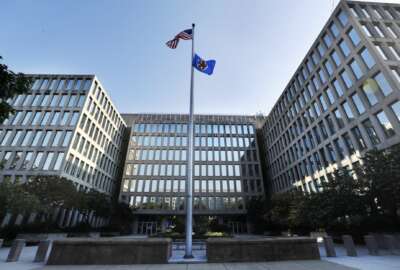
Trump administration cites OPM’s financial uncertainty in making case for reorganization
The Trump administration has confirmed that the Office of Personnel Management will operate on shaky financial ground after the security clearance business moves to...
Best listening experience is on Chrome, Firefox or Safari. Subscribe to Federal Drive’s daily audio interviews on Apple Podcasts or PodcastOne.
Financial uncertainty at the Office of Personnel Management is prompting the Trump administration this week to more actively push for a complete reorganization of the agency.
It’s the first time the administration has admitted that OPM, which depends on a revolving fund worth $1.68 billion in fiscal 2019, will be on shaky ground when the National Background Investigations Bureau and its security clearance business moves to the Defense Department on Oct. 1.
Specifically, OPM will face a funding shortfall of roughly $70 million when NBIB and its security clearance business leaves the agency for the Pentagon, Margaret Weichert, OPM’s acting director and deputy director for management at the Office of Management and Budget, said Tuesday.
And it’s one several reasons the Trump administration has given for the OPM reorganization in its “case for change,” which it has shared with the press and lawmakers this week. The case for change comes ahead of a hearing scheduled next Tuesday before the House Oversight and Reform’s Government Operations Subcommittee.
When the proposal to reorganize OPM was first made public last June, the administration said it was the agency’s poor handling of the 2015 data breaches and a seemingly insurmountable backlog of 700,000 pending clearances at the National Background Investigations Bureau that necessitated the need for change.
Margaret Weichert, OPM’s acting director and the Office of Management and Budget’s deputy director for management, has described the need to elevate the status of human capital management for the federal workforce to a central office within the Executive Office of President as another reason for the reorganization.
OPM as it exists today is too distracted by activities that lie outside of the mission of a central personnel office, the administration has said.
But this week, the administration has publicly acknowledged OPM stands to lose 81% of the revenue its generates today by processing security clearances. When the governmentwide security clearance program moves from OPM to DoD, $1.3 billion in revenue will go with it.
After months of anticipation, President Donald Trump made the security clearance transfer official last month with an executive order. NBIB’s resources, authorities, workforce and security clearances are expected to move to DoD by Oct. 1, though the OPM chief information officer will continue to manage the IT system that processes those clearances for an indefinite period of time.
NBIB Director Charlie Phalen told reporters this week DoD is expected to reimburse OPM for the continued use of that IT system and potentially others, though the exact numbers are still being worked out.
The loss of NBIB’s security clearance business will leave OPM with $386 million in revolving business, plus $265 million in discretionary budget authority through appropriations, the administration said Tuesday.
OPM, as Federal News Network reported back in 2017, quietly warned Congress that the move of any significant part of the agency’s security clearance business would spark serious financial uncertainty. But Congress authorized the move of defense-related background investigations to DoD in the 2018 defense authorization bill.
The Trump administration several months later announced its plans to transfer all security clearance business to the Pentagon. As part of its government reorganization proposal, it also announced plans to move OPM’s HR Solutions and retirement and health services to the General Services Administration.
Federal personnel policy development would move to a new office at the Executive Office of the President. That office would be modeled after the Office of Federal Procurement Policy. The administration requested $400,000 for the creation of a new workforce policy office and budgeted three people to staff it.
Though the President authorized the move of OPM’s security clearance business with an executive order, the administration needs Congress to authorize the move of other OPM functions to GSA.
Though some senators expressed concern last week they hadn’t seen the plans or rationale for the OPM reorganization, the administration’s toughest critics may reside in the House.
Subcommittee Chairman Gerry Connolly (D-Va.) had requested a long list of documents ahead of next week’s hearing, including a cost-benefit analysis for moving multiple OPM functions to GSA, a list of legal authorities that OPM and GSA have or would need to carry out the reorganization and evidence that shows how OPM employees have been involved in reorganization planning.
Connolly has said as recently as last week that OPM hadn’t offered “a scrap” of information detailing the rationale for the proposed reorganization. OPM has told Federal News Network that it has provided documents to the subcommittee.
Few details exist to date about the administration’s plan for the reorganization. The President’s budget request offered up little information about the plans for the OPM-GSA merger, other than a request for $50 million to cover the initial costs of the reorganization.
It included no other details that describe how many employees might be impacted or how the administration expects to address financial uncertainties that would likely come with moving OPM functions in phases. Weichert has said no OPM employees would lose their jobs as a result of the reorganization.
According to the administration, the OPM reorg may generate annual savings, though it doesn’t specify when those savings may be realized.
“The reorganization could eventually result in annual savings between $11 and $37 million that would be realized through long term efficiencies and consolidations,” according to a document described as a “case for change,” which the administration provided to reporters ahead of a Tuesday afternoon press briefing. “Additionally, by combining GSA’s expertise in managing procurement and physical space and OPM’s expertise in human capital management, we can enable new self-funding activities and create another avenue of support for the collective mission.”
Copyright © 2025 Federal News Network. All rights reserved. This website is not intended for users located within the European Economic Area.
Nicole Ogrysko is a reporter for Federal News Network focusing on the federal workforce and federal pay and benefits.
Follow @nogryskoWFED
Related Stories






